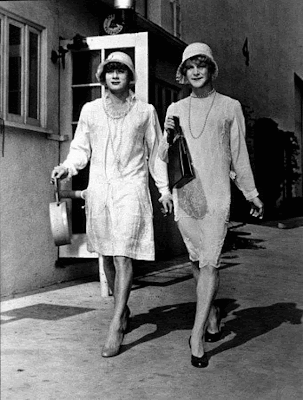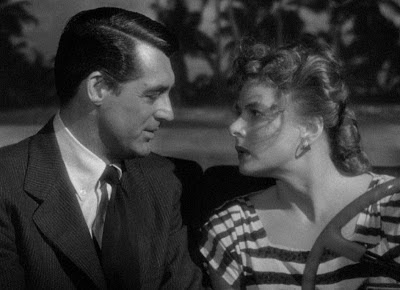Is it true that "the song remains the same" if played to a different tune? You decide whether The Way We Were can still outdo What Might Have Been:
Marlene and John Gilbert take on the town.
Marlene Dietrich is remembered in cinematic history as being a stone cold... fox. Yet, off screen, her character was much softer and more maternal than any of her performances could have relayed. She would only play a mother once, in Blonde Venus, despite the fact that "mom" was her favorite role in her personal life. Her natural inclination to nurture soon enough drew her to none other than fallen angel John Gilbert. When Lewis Milestone alerted her over dinner that his neighbor, the handsome Jack, was out of work, melancholy, and just doors away, Marlene-- who strongly adhered to the "no man left behind" mentality-- marched up to his house and announced, "John Gilbert, I have come to save you." The stunned heartthrob made no dispute. In addition to enjoying a romantic affair, Marlene also vowed to kick-start Jack's stalled career by insisting that he be cast opposite her in Knight without Armour. It would have been something to see these two lovers together on screen. Sadly, Jack passed away on Jan. 9, 1936 before production was started, so Greta Garbo maintains the reputation of his greatest screen lover (both on and off). Marlene was devastated at Jack's passing and lit votive candles beneath his picture in memory for several months afterward. Yet, she did not hold it against the debonair Robert Donat when he later took on the role of A.J. Fothergill in Knight. In fact, Marlene turned her mother instincts on him as well. When he became ill, production threatened to have him replaced. Again, Marlene stepped in and insisted that the film be postponed until its leading man was better, or else she too would walk. The brass took the bait, and after the grateful Robert recuperated, Marlene toasted his return.

Robert Donat plays Marlene's Knight without Armour,
though in life she was the hero.


Paulette Goddard could definitely pull off the femme fatale,
but she was no match for Marlene.

George Burns had been acting in movies for over 45 years by the time he was cast in The Sunshine Boys. Co-starring Walter Matthau (together right), this film was a precursor to the aging frenemy films that Walter and Jack Lemmon would make later, such as Grumpy Old Men. In Sunshine, the two heroes are old-- and I do mean old-- show business partners, whose days in vaudeville made them stars in their own time but leave them forgotten in present day. However, an opportunity to earn some bookoo bucks and regain former glory comes when they are offered a performance on a television special. The reunion is an unwelcome one, as the two curmudgeons can't stand each other. Chaos ensues. The brilliant comic sparring of George and Walter made the film a surprising hit for a world continually described as youth-centric. George with his dry, crotchety delivery, even won an Academy Award for his performance-- a first for a man of 80. This was a very moving moment in his life, particularly since he was not even slated to star in the film originally. In the beginning, his good friend, the much beloved Jack Benny, was to play Al Lewis, but sadly Benny was in poor health and could not accept the project. After making some initial screen tests with Walter, Benny backed out to rest and hopefully recuperate. Always a gentleman, he recommended his friend George for his abandoned role, which George of course accepted. Not long after, Benny passed away. Thus, when George accepted his long-awaited Oscar, he accepted it not only for himself, but on behalf of his dear, departed friend, without whom he never would have embraced the long-awaited statuette.

George Burns and Jack Benny make beautiful music together.

The Thin Man is a perfect example of the little movie that could. Based upon the mystery novel by Dashiell Hammett, it was given a modest budget by MGM and was ranked during production as a simple B-feature. Always up to the challenge, director W.S. Van Dyke was able to churn out the comedy classic in the allotted two weeks, but even more impressive than his economy was his casting palette. The dynamite combo of William Powell and Myrna Loy as the playfully bickering Nick and Nora Charles (left) remains one for the ages. Though the two had performed together before, in Manhattan Melodrama, their chemistry reached true perfection once they started pulling punches amidst the hilarity of murder and marital discord. Their onscreen relationship was amplified by their offscreen friendship, and a mutual trust and affection would bring theaters-goers their first glimpse of a modern marriage: oozing sarcasm, often drunken, and forever in love. The pairing too became a triple threat when dog Skippy was added to the mix as Asta, who would become yet another beloved dog performer in the ranks of Rin Tin Tin and Lassie. But this hysterical family was almost broken up when William became ill with cancer, which took him off the screen for a year and put a wrench in Thin Man sequels. Because MGM didn't want to lose money on wasted time, they considered replacing William in the continuing series with another actor. Both Melvyn Douglas and Reginald Gardner were considered. Luckily, the studio didn't follow through. The magic of Nick and Nora couldn't be duplicated by anyone other than Bill and Myrn'. After William recuperated, he returned to his favorite cinematic wife with their reign through six Thin Man films never interrupted.

Keep your paws off: this trio's built to last.

Some Like It Hot has been hailed by many as the greatest comedy of all time, which is ironic considering that behind the scenes there was nothing but drama. Most of this centered around the forever conflicted and perpetually late Marilyn Monroe (right), but even Billy Wilder admitted that all the pain was worth it when he saw the rushes. The great comic teaming of handsome cad Tony Curtis and the devilishly absurd Jack Lemmon perfected the onscreen chemistry, and smaller character roles were filled out synchronously by George Raft and Joe E. Brown. It turned out to be a motley match made in Heaven. Who could imagine a better outcome? It is fortunate for continuing audience members that Billy Wilder did not go with his original casting idea for Joe/Josephine and Jerry/Daphne: Danny Kaye and Bob Hope. Some like it not. While definitely superb in the funny department, this duo would not have delivered the same edge nor the necessary sexuality that made the film such a hit. The more youthful albeit worldly interpretations of Tony and Jack definitely turned up the heat in the script. Billy soon latched onto Jack Lemmon after seeing some of the upcoming actor's work, and after Tony campaigned for the role of Joe and proved his acting ability in Sweet Smell of Success, he too was put in heels. Yet, even then, the pairing was in jeopardy. Billy knew he needed a star to bring in an audience, so when Frank Sinatra considered edging in on the role of Jerry/Daphne, the production was put on hold. Thankfully, the macho Sinatra decided that his image wouldn't survive a picture in which he dressed in drag, and the role was gladly handed back to Jack. As for the role of Sugar Kane, originally Mitzi Gaynor was slated to be the one "runnin' wild" with her ukulele, but having "Marilyn Monroe" on the marquee was a better guarantee for revenue. Marilyn had her reservations about playing another dumb blonde, but despite their experience together on The Seven Year Itch, Billy talked her into it. One of Hollywood's finest directors, he was able to maintain control of his haywire film, even with the infamous Black Bart (Paula Strasberg) lurking around set, though handling Marilyn the woman was a chore no one could accomplish. Nonetheless, the film was a sensation, and Marilyn won the Golden Globe for her endearing performance. Thank movie Heaven!

As fate would have it: apparently Sinatra had the pipes,
but lacked the stems. Tony and Jack rocked stilettos
and made it work.




























